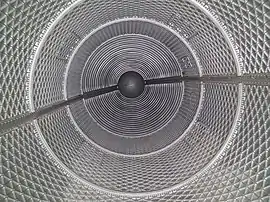PSLV-C2
PSLV-C2 was the second operational launch and overall fifth mission of the PSLV program. This launch was also the forty-third launch by Indian Space Research Organisation since its first mission on 1 January 1962. The vehicle carried three satellites which were deployed in the Sun-synchronous low Earth orbit.[1][2][3][4][5] The vehicle carried India's first remote sensing satellite Oceansat-1 (IRS-P4) as the main payload. It also carried South Korean satellite Kitsat-3 and German satellite DLR-Tubsat as auxiliary payloads.[1] PSLV-C2 was the first Indian Expendable launch vehicle to carry and deploy more than one satellite in a mission. This was also India's and ISRO's first commercial spaceflight where South Korea and Germany each paid $1.0 million (equivalent to $1.53 million in 2019) to ISRO for launching their satellites.[5][6]
 Model of the PSLV rocket | |
| Mission type | Deployment of three satellites. |
|---|---|
| Operator | ISRO |
| Website | ISRO website |
| Mission duration | 1117.5 seconds |
| Apogee | 735.1 kilometres (457 mi) |
| Spacecraft properties | |
| Spacecraft | Polar Satellite Launch Vehicle |
| Spacecraft type | Expendable launch vehicle |
| Manufacturer | ISRO |
| Launch mass | 294,000 kilograms (648,000 lb) |
| Payload mass | 1,202 kilograms (2,650 lb) |
| Start of mission | |
| Launch date | 11:52:00, May 26, 1999 (IST) (IST) |
| Rocket | Polar Satellite Launch Vehicle |
| Launch site | Sriharikota Launching Range |
| Contractor | ISRO |
| End of mission | |
| Disposal | Placed in graveyard orbit |
| Deactivated | 26 May 1999 |
| Orbital parameters | |
| Reference system | Sun-synchronous |
| Regime | Low Earth orbit |
| Payload | |
Mission parameters
- Mass:
- Total liftoff weight: 294,000 kilograms (648,000 lb)
- Payload weight: 1,202 kilograms (2,650 lb)
- Overall height: 44.4 metres (145.7 ft)
- Propellant:
- First stage: Solid HTPB based (138.0 + 54 tonnes)
- Second stage: Liquid UDMH + N
2O
4 (4.06 tonnes) - Third stage: Solid HTPB based (7.2 tonnes)
- Fourth stage: Liquid MMH + N
2O
4 (2.0 tonnes)
- Engine:
- First stage: S139
- Second stage: Vikas
- Third stage:
- Fourth stage: 2 x PS-4
- Thrust:
- Altitude: 735.1 kilometres (457 mi)
- Maximum velocity: 7,490 metres per second (24,573 ft/s) (recorded at time of fourth stage ignition)
- Duration: 1117.5 seconds
Payload
PSLV-C2 carried and deployed total three satellites. Oceansat-1 (IRS-P4) was the main payload and Kitsat-3 and DLR-Tubsat were two auxiliary payloads that were mounted on PSLV-C2 equipment bay diametrically opposite to each other. Oceansat-1, was mounted on top of the equipment bay. In the flight sequence, IRS-P4 was injected first, followed by Kitsat-3 and then DLR-Tubsat.[1][8][9]
| Country | Name | Nos | Mass | Type | Objective |
|---|---|---|---|---|---|
| Oceansat-1 | 1 | 1,050 kg | Indian Remote Sensing Satellite | Remote sensing | |
| Kitsat-3 | 1 | 107 kg | Microsatellite | Test & demonstrate new satellite bus & its payloads | |
| DLR-Tubsat | 1 | 45 kg | Microsatellite | Test newly developed attitude control system | |
Launch & planned flight profile

PSLV-C2 was launched at 11:52 a.m. IST on 26 May 1999 from Satish Dhawan Space Centre (then called "Sriharikota Launching Range"). The mission was planned with pre-flight prediction of perigee and apogee of 727 km (±35 km). The actual perigee was 723.1 km, apogee was 735.1 km. Following was the planned flight profile.[1][2][3][4][5][7]
| Stage | Time (seconds) | Altitude (kilometer) | Velocity (meter/sec) | Event | Remarks |
|---|---|---|---|---|---|
| First stage | T+0 | 0.02 | 450 | First stage ignition | Lift-off |
| T+1.2 | 0.02 | 450 | Ignition of 4 ground-lit strap-on motors | ||
| T+25.1 | 2.43 | 540 | Ignition of 2 air-lit strap-on motors | ||
| T+68.1 | 23.10 | 1,100 | Separation of 4 ground-lit strap-on motors | ||
| T+90.1 | 40.21 | 1,520 | Separation of 2 air-lit strap-on motors | ||
| T+117.7 | 72.08 | 1,970 | First stage separation | ||
| Second stage | T+117.9 | 72.38 | 1,970 | Second stage ignition | |
| T+162.7 | 120.71 | 2,210 | Heat shield separation | ||
| T+167.7 | 126.60 | 2,260 | Closed-loop guidance initiation | ||
| T+284.5 | 254.03 | 4,070 | Second stage separation | ||
| Third stage | T+285.7 | 255.46 | 4,060 | Third stage ignition | |
| T+506.4 | 533.57 | 5,970 | Third stage separation | ||
| Fourth stage | T+584.4 | 605.44 | 5,870 | Fourth stage ignition | |
| T+991.7 | 728.25 | 7,490 | Fourth stage thrust cut-off | ||
| T+1017.5 | 728.66 | 7,490 | Oceansat-1 (IRS-P4) separation | ||
| T+1067.5 | 729.51 | 7,490 | Kitsat-3 separation | ||
| T+1117.5 | 730.41 | 7,490 | DLR-Tubsat separation | ||
The launch was witnessed by Atal Bihari Vajpayee (then Prime Minister of India), Murli Manohar Joshi, Vasundhara Raje and N. Chandrababu Naidu.[6]
References
- "PSLV-C2". Indian Space Research Organisation. Retrieved 9 Jul 2016.
- "Space Launch Report: PSLV". spacelaunchreport.com. Retrieved 9 Jul 2016.
- "ISRO timeline since 1960s". Indian Space Research Organisation. Retrieved 9 Jul 2016.
- "PSLV-C2 mission". iisc.ernet.in. Retrieved 9 Jul 2016.
- "The science and commerce of PSLV". Frontline. Retrieved 9 Jul 2016.
- "PSLV Successfully Launches Three Satellites". Press Information Bureau. Retrieved 9 Jul 2016.
- "PSLV-C2 brochure" (PDF). Indian Space Research Organisation. Retrieved 9 Jul 2016.
- "Korea Institute of Technology Satellite-3". eoportal.org. Retrieved 9 Jul 2016.
- "TUBSAT (Technical University of Berlin Satellite) Program". eoportal.org. Retrieved 9 Jul 2016.
